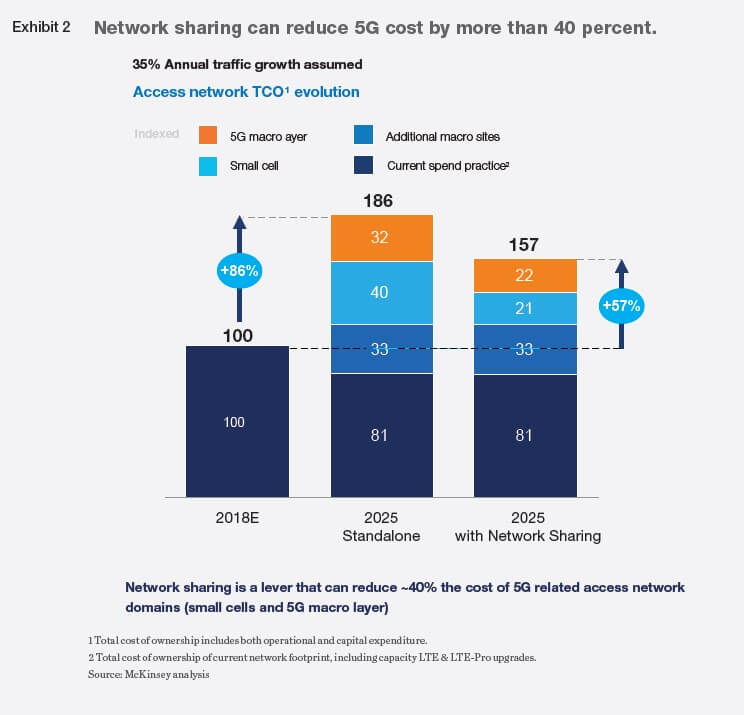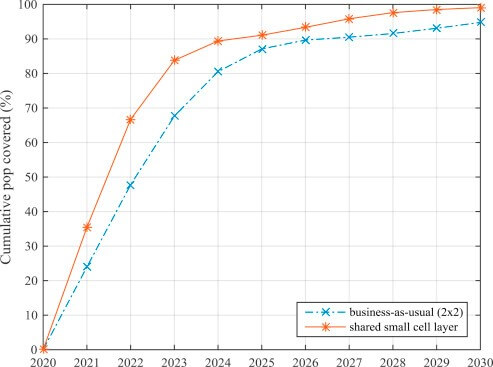Does network sharing deliver economic benefits? If it does, how can performance be managed to ensure equitable access and optimised service delivery for each stakeholder?
Perhaps the best known of the many challenges presented by 5G is the need to massively increase the number of cell sites. Densification, as it is more commonly described, is the process through which a huge number of calls – a combination of macro, small, Femto and others – will be used to provide the coverage required to deliver the promised performance of 5G.
Of course, this costs money, so mobile network operators (MNOs) that hold spectrum licenses and which are obliged by regulators to meet coverage targets within specified time periods are, naturally, anxious about how they will achieve this – not only in urban environments (where coverage can be hard to achieve because of urban architecture and indoor penetration) but also in more remote areas (where coverage needs to be spread to more scattered populations and may be challenged by natural topology and features).
One solution to this that has been proposed is network sharing. With network sharing, MNOs can use common assets to help complete coverage. So, MNO A might enable MNOs B and C to use radio sites in one location, while B does the same for A and C in another. There are several approaches to sharing that are in discussion – another is the provision of an MNO-neutral network by a third party that can then be used by A, B and C through wholesale models.
As a result, network sharing is the subject of much discussion. But, does it really deliver the benefits expected? Recent research suggests that it does – across two dimensions – speed of obtaining coverage, and cost.
For example, according to a
recent publication by McKinsey, network sharing could reduce costs by more than 40%, as Figure 1 illustrates.
Figure 1 – Cost reduction through network sharing (McKinsey)
In support of this, the authors pointed to existing efforts to support network sharing, which had been permitted in several countries over the last decade or so, allowing experience to be developed and refined. Consequently, some regulators have taken the view the network sharing is an instrument that they wish to support, in order to meet deployment targets to boost economic goals for society at large.
An interesting analysis by Oughton and Frias [1] also shed light on the second dimension. According to their research, Oughton and Frias found that network sharing can have a significant effect in bringing forward the point at which 90% of population coverage can be achieved. This is important, because the cost of deploying infrastructure grows massively as 100% is reached – in other words, it costs more to provide coverage for the hardest to reach locations. The impact is shown in Figure 2.
Oughton and Frias modelled several scenarios and compared with “business as usual”, which would be the deployment rate without sharing. For many regulators, it is imperative to ensure national coverage as quickly as possible, so as to ensure there is no growth in the digital divide, as happened with previous generations of mobile technology.
Figure 2: Rollout for 2020 – 2030 based on business as usual vs infrastructure [network] sharing [2]
IBID [2]
Network sharing thus delivers two essential benefits:
- Reducing investment costs
- Accelerating coverage deployment
So, we can expect to see significant growth in network sharing projects and activities. But, this raises the question of the equitable management of the resources made available under the different models. Each MNO will need to be sure that they can deliver the services they require across shared infrastructure, without undue competition for resource.
Since 5G is supposed to support multiple services (eMBB, URLLC, mIoT and FWA), this is particularly important – one MNO may seek to deliver an entirely different set of services from another at the same location.
To achieve this, real-time RAN management will be required. That’s where we come in. Tambora’s solution enables dynamic mobile network sharing, allowing assets to be used fairly, while supporting different MNO service portfolios and active network slices.
That’s because our solution acts at the session level, allowing service differentiation. It also enables different mobile operators and service providers to control resources independently, allowing real-time RAN management for different network slices. Because each operator can obtain the specific performance they require, a shared dense access network can be delivered, cost-effectively and managed via closed loop feedback.
Traffic is intelligently detected and automated, policy-driven real-time decisions are taken regarding routing – at the network edge, where it matters. Traffic can be rerouted via less congested cells, offloaded to Wi-Fi networks, or broken out to content servers, reducing network load. This can be achieved dynamically, for each session, user or application, resulting in efficient network sharing.
So, while the cost benefits and economic development advantages of network sharing are becoming clearer, the need to ensure optimisation is also growing. If you are considering network sharing, as an MNO, infrastructure provider or regulator, then you should
talk to our team to learn how to really unlock the performance potential of sharing models.
[1] Oughton, F & Frias, Z “The cost, coverage and rollout implications of 5G infrastructure in Britain”, Telecommunications Policy V42, 636-652
[2] IBID

